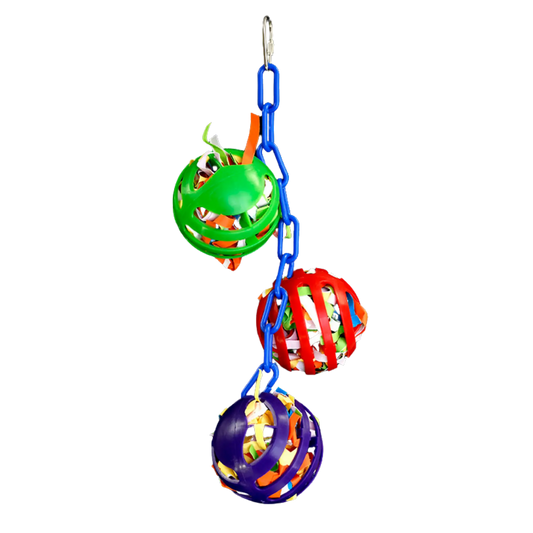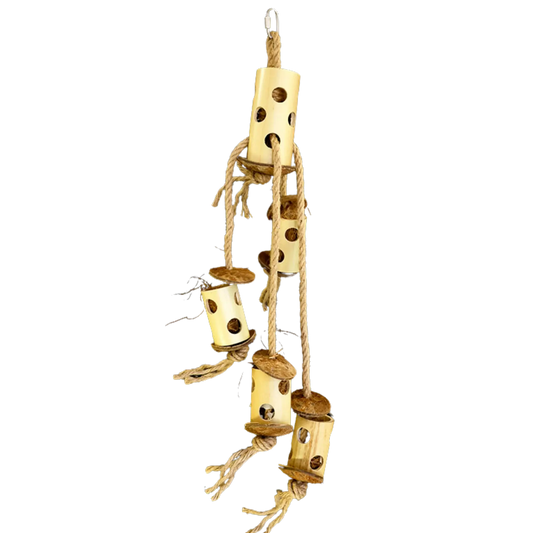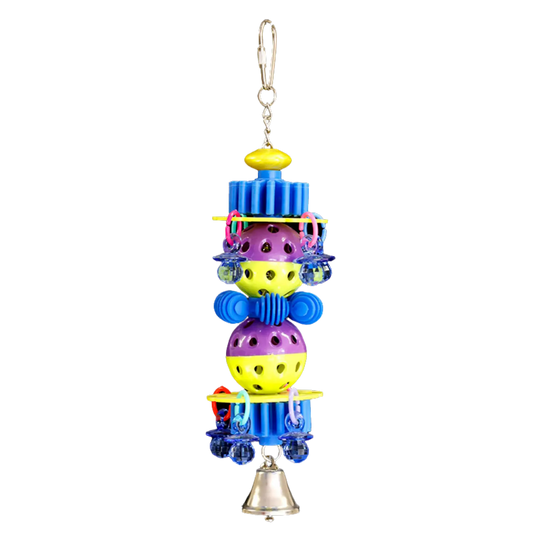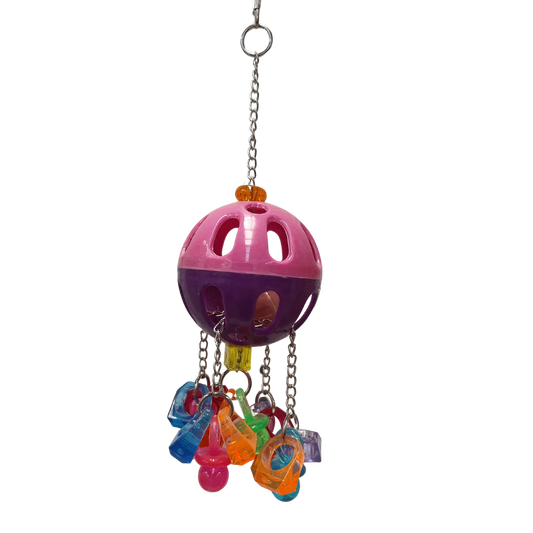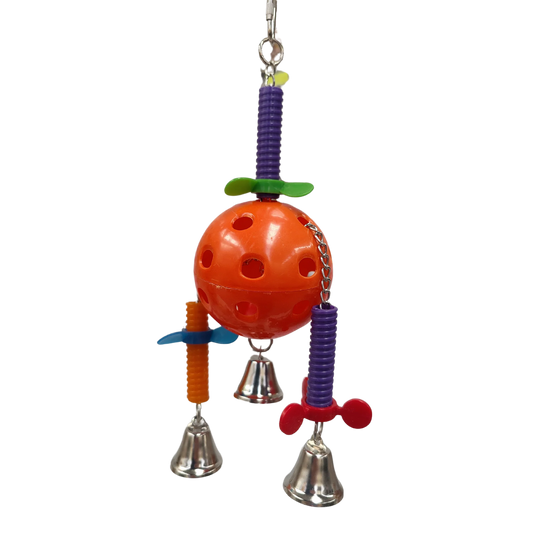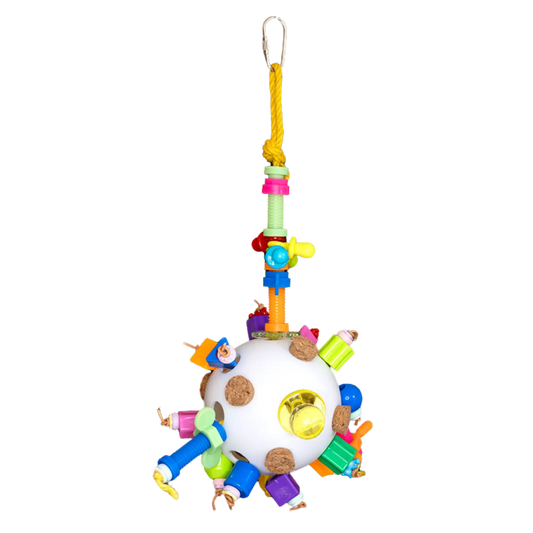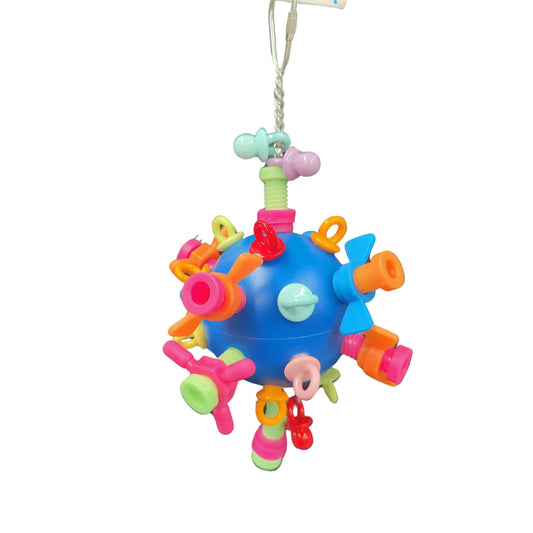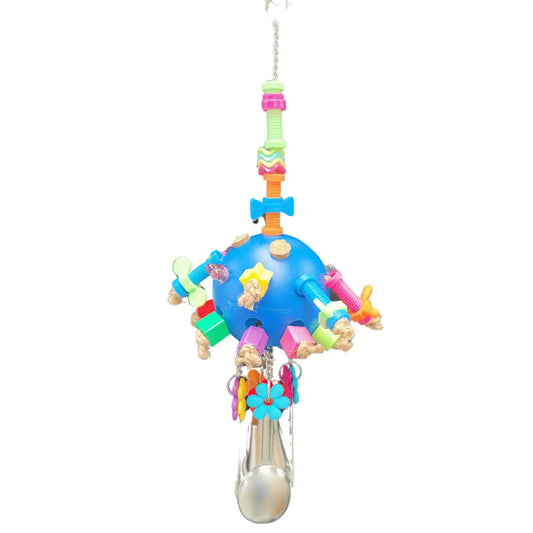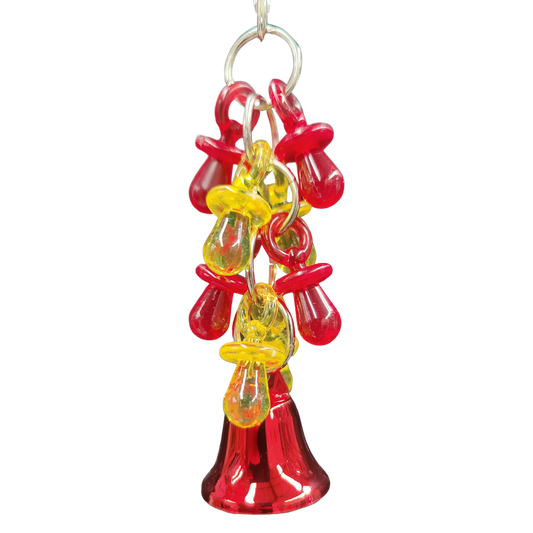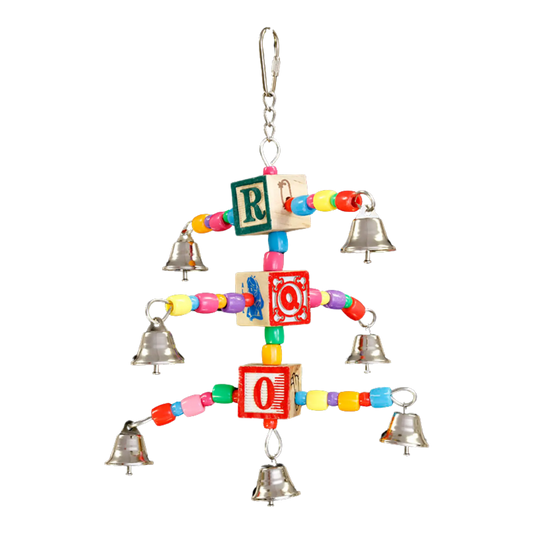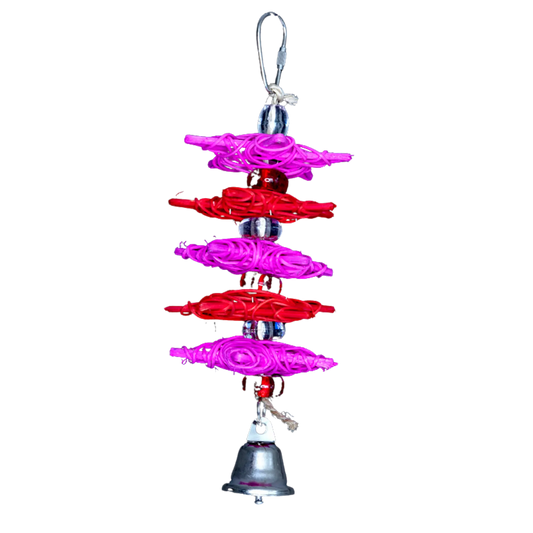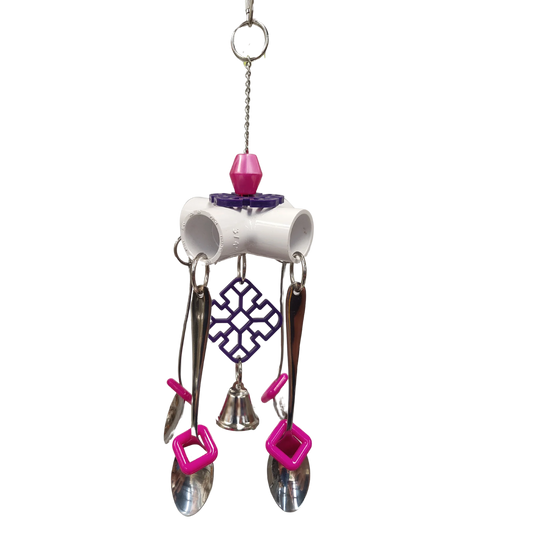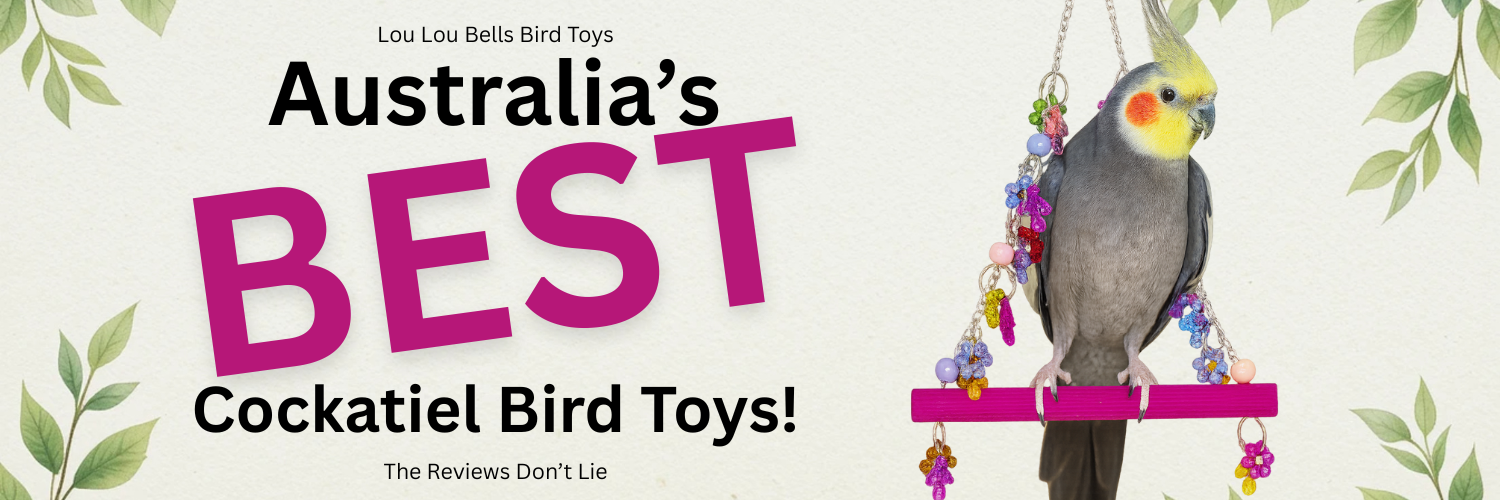Cockatiel Bird Toys
Discover the best bird toys for cockatiels — safe, colourful, and designed to keep your feathered friend happy, active, and mentally stimulated. From bells and foraging toys to shreddables and chewables, explore toys that nurture your cockatiel’s natural instincts while reducing boredom and stress-related behaviours. Proudly Australian owned and loved by birds across the country, Lou Lou Bells Bird Toys are your cockatiel’s new favourite pastime.
Understanding Your Cockatiel’s Playful Nature
If you’ve ever watched a cockatiel explore their cage, you already know how playful, cheeky, and curious they are. These small parrots are full of energy and thrive on stimulation. In the wild, cockatiels spend most of their day flying, socialising, and foraging for food. In captivity, they rely on you — and the right toys — to provide that same level of excitement and engagement.
A bored cockatiel is not a happy cockatiel. Without enough mental and physical stimulation, they can develop stress-related behaviours like feather plucking, loud calling, or even aggression. The right toys do more than just entertain — they enrich your bird’s daily life, encourage exercise, and mimic the challenges they’d naturally face in the wild.
Toys are also a fantastic bonding tool. When your cockatiel sees you introducing something new, it triggers curiosity and trust. They’ll often hop over, explore, and play — and before long, they’ll start to associate playtime with your presence, deepening your connection.
Types of Toys Cockatiels Love
Not all toys are created equal. Each cockatiel has their own personality, and what excites one might not interest another. A good rule of thumb is to offer a mix of toy types and rotate them regularly to keep your bird’s environment fresh and engaging. Here are the main types of toys every cockatiel should have:
1. Bell Toys
Cockatiels are drawn to sound — they love jingling, rattling, and chiming toys that reward their curiosity with noise. Bell toys mimic social sounds and help keep your bird’s mind alert. A great option is the Bell Toys for Cockatiels, designed for safe, gentle play that encourages pecking and exploration.
These toys often become favourites because they appeal to your cockatiel’s playful personality and love for rhythm. Some even start to whistle or chirp back at the sound!
2. Foraging Toys
Foraging toys challenge your bird to think, explore, and work for their treats — just like they would in nature. You can hide bits of millet, seed, or dried herbs inside them, encouraging your cockatiel to peck, chew, and problem-solve.
Foraging keeps your bird busy and reduces boredom-based behaviours. It’s also a healthy way to make snack time last longer and promote exercise.
3. Shreddable Toys
There’s nothing more satisfying to a cockatiel than tearing something apart. Shreddable toys made from paper, cane, or natural fibres allow your bird to safely chew, destroy, and rebuild — all instincts deeply rooted in their DNA.
These toys help with beak maintenance too. Constant gentle chewing keeps their beak trim and strong. Toys like the Crinkle Crinkle Little Star Bird Toy are perfect for this — colourful, textural, and delightfully crinkly to shred!
4. Hanging and Dangly Toys
Hanging toys add movement, which instantly captures a cockatiel’s attention. They swing, jingle, and sway, giving your bird an interactive experience that keeps them active and entertained.
A great choice is the Dangly Croc Bird Toy, which combines bright textures and motion for hours of fun. Hanging toys are especially useful for single birds, as they provide both entertainment and comfort when their human companions aren’t around.
5. Natural and Wooden Toys
Cockatiels have a natural instinct to chew. Wooden toys made from safe, untreated wood (like pine or balsa) allow them to satisfy this instinct safely. Natural materials also help keep their beak in good shape and give them a sense of familiarity — like chewing on a branch in the wild.
Always make sure any wooden toys are bird-safe and free of toxic dyes or glues. That’s why all Lou Lou Bells Bird Toys are carefully crafted with safety and natural play in mind.
Why Toys Are More Than Just Fun
For a cockatiel, toys are not a luxury — they’re a necessity. Just like humans, cockatiels can suffer from boredom, stress, and loneliness. Toys help fill their day with mental challenges, exploration, and joy.
Without them, birds often begin to show destructive habits, like chewing their feathers, biting, or pacing back and forth. These behaviours aren’t “naughty” — they’re signs of frustration and a cry for enrichment.
Toys that are engaging and colourful — especially ones that reduce boredom and stress-related behaviours for Cockatiels — can make a world of difference. They help your cockatiel express natural instincts safely while keeping their mind sharp and body active.
When birds play, they’re not just having fun; they’re developing coordination, confidence, and resilience. Playtime also helps relieve anxiety, especially if your bird is adjusting to a new environment or recovering from a stressful experience.
How Many Toys Should a Cockatiel Have?
There’s no magic number, but a good rule is to have at least four to six toys in their cage at any time, and rotate them every week or two. This keeps things interesting and prevents overstimulation.
A variety of textures and types — such as bells, wood, and foraging puzzles — ensures your cockatiel is mentally engaged. Don’t forget to include toys outside the cage too, especially if your bird has daily out-of-cage playtime. A small play gym or a hanging toy tree makes the perfect playground.
Safety Tips for Choosing Toys
Safety always comes first. Cockatiels are curious by nature and will explore every new object with their beak, so avoid anything that could cause harm.
- ✅ Choose toys made from bird-safe materials — no toxic metals, treated wood, or unsafe glues.
- ✅ Avoid loose threads or frayed ropes, which can wrap around your bird’s toes or neck.
- ✅ Make sure bells have enclosed clappers so your bird can’t get their beak stuck.
- ✅ Rotate and inspect toys regularly for wear and tear.
- ✅ Choose size-appropriate toys — cockatiel-sized toys are best, not large parrot ones.
All Lou Lou Bells Bird Toys are designed with these safety standards in mind — made for play, not worry.
Encouraging Play and Curiosity
Some cockatiels jump into play instantly, while others need a little encouragement. If your bird seems hesitant about a new toy, don’t worry — they’re just being cautious.
- Place the toy near their favourite perch, where they feel most comfortable.
- Play with the toy yourself — show it off, move it gently, or tap it to make sound.
- Offer treats when they approach or touch the toy.
- Talk to your bird as they explore; your voice reassures them.
Within a few days, your cockatiel will likely start exploring and interacting with the toy. Once they learn it’s safe and fun, you’ll see their playful personality shine.
Creating a Fun, Enriched Environment
An enriched environment goes beyond toys. It’s about creating variety, stimulation, and joy throughout your cockatiel’s day.
- Adding perches of different textures and diameters to keep their feet healthy.
- Introducing foraging challenges, like hiding treats inside paper cups or small boxes.
- Offering safe branches or natural chewables from bird-safe trees like apple or bottlebrush.
- Using background music or gentle whistling to keep them company.
- Letting them explore safely outside the cage for supervised playtime.
Toys are the heart of this enrichment. They provide structure, creativity, and exercise — everything a clever little bird like a cockatiel needs to thrive.
Handmade Quality, Australian Love
Lou Lou Bells Bird Toys are proudly Australian owned, and every toy is designed with care, quality, and love for birds at the forefront. Many are sourced or crafted from natural, safe materials that reflect the kind of stimulation birds enjoy in the wild.
Our toys are tested and loved by bird owners nationwide, from budgies and cockatiels to conures and galahs. Each piece is thoughtfully created to spark curiosity, inspire play, and bring a touch of joy to your bird’s everyday life.
Final Thoughts: Playtime is Happiness
Your cockatiel’s toys are more than cage decorations — they’re tools of expression, discovery, and happiness. The right mix of sound, texture, and challenge can completely transform your bird’s day, giving them purpose and pleasure.
Whether it’s a jingling bell toy, a colourful chewable, or a dangling surprise like the Dangly Croc Bird Toy, every new plaything is a small adventure waiting to happen.
So go ahead — fill their world with joy. Watch them climb, peck, whistle, and dance their way through a life that’s full of colour, sound, and love. With the perfect toys from Lou Lou Bells Bird Toys, your cockatiel won’t just live — they’ll thrive.
Read More
What Type Of Toys Do Cockatiels Like
Some Questions About Cockatiel Bird Toys
1. What kind of toys are best for Cockatiels?
Cockatiels are intelligent, playful, and social birds that thrive on interaction and mental stimulation. The best toys for Cockatiels are those that keep them mentally and physically active. Popular types include bells, chewable toys, hanging toys, and foraging puzzles. For example, our Bell Toys for Cockatiels are a favourite — the gentle chime keeps them entertained for hours while satisfying their curiosity.
Chewable toys made from bird-safe materials like untreated wood, coconut, paper, or sisal are essential for maintaining beak health. Hanging toys, on the other hand, encourage movement and play — perfect for Cockatiels who love to climb and swing. Toys with colourful parts and textures, such as our Dangly Croc Bird Toy, add extra excitement to their day and help prevent boredom.
Always rotate toys weekly to keep your Cockatiel curious and engaged. This not only keeps their environment fresh but also helps avoid destructive or repetitive behaviours caused by boredom.
2. How do toys benefit my Cockatiel’s behaviour and wellbeing?
Toys play a critical role in your Cockatiel’s happiness and overall health. Without enough stimulation, Cockatiels can become bored, stressed, or even develop negative habits such as feather plucking or excessive screaming. By adding interactive toys to their cage, you give them a healthy outlet for their natural instincts to chew, explore, and play.
For example, toys that include gentle bells or reflective elements can reduce boredom and stress-related behaviours for Cockatiels. Chew toys satisfy their need to gnaw, while foraging toys mimic natural feeding behaviours — making mealtime fun and engaging. You can also hide small treats inside toys to challenge their intelligence and promote problem-solving skills.
Social enrichment is just as important. Many Cockatiels treat their toys like companions, singing or chatting to them throughout the day. Toys like the Crinkle Crinkle Little Star Bird Toy provide both tactile and auditory stimulation, which helps to improve emotional balance and reduce stress levels. A happy Cockatiel is a playful, talkative, and confident bird!
3. How many toys should I give my Cockatiel?
The ideal number of toys depends on your bird’s personality and the size of their cage. As a general rule, you should aim to have at least 4–6 different types of toys available at any time. Include a mix of hanging, chewable, and foraging options to create variety. For smaller cages, rotate the toys weekly to keep things interesting without overcrowding the space.
Keep in mind that Cockatiels can get bored if they see the same toys every day. Rotating toys and introducing new ones regularly keeps their environment stimulating. This routine not only supports physical exercise but also encourages exploration and curiosity, promoting a well-rounded and joyful temperament.
4. Are your toys safe for Cockatiels?
Absolutely. All Lou Lou Bells Bird Toys are crafted or sourced with your bird’s safety in mind. We only use bird-safe, non-toxic materials such as natural wood, vegetable-dyed rope, stainless steel, and untreated sisal. No glues, paints, or harmful chemicals are ever used in the production of our toys.
We understand how important safety is — which is why we recommend checking toys regularly for wear and tear. Replace them if you notice any frayed cords, broken parts, or sharp edges. Your Cockatiel’s wellbeing always comes first, and with Lou Lou Bells Bird Toys, you can trust you’re providing high-quality, safe, and stimulating products every time.
Explore our full collection of Cockatiel Bird Toys to find the perfect mix for your feathered friend. From bells to chewable blocks, each toy is designed to promote happiness, health, and play.
Safety Note: Always supervise your bird when introducing new toys, and ensure they are the right size for your Cockatiel to prevent accidental entanglement or ingestion.

